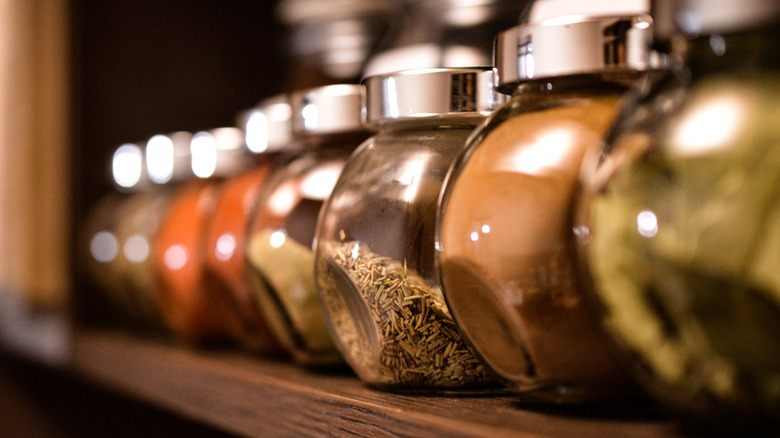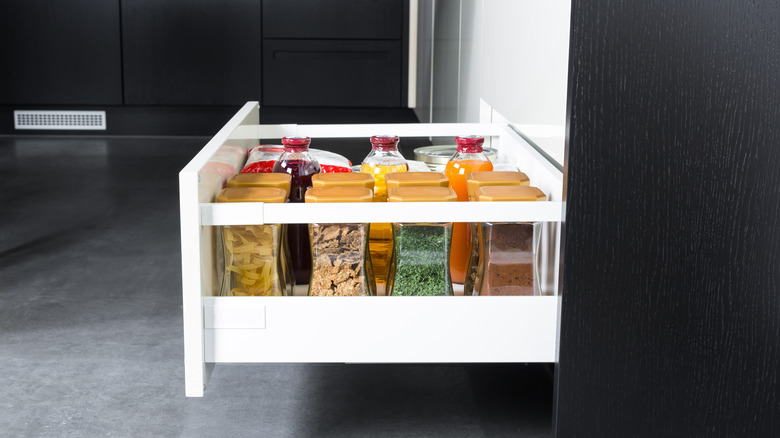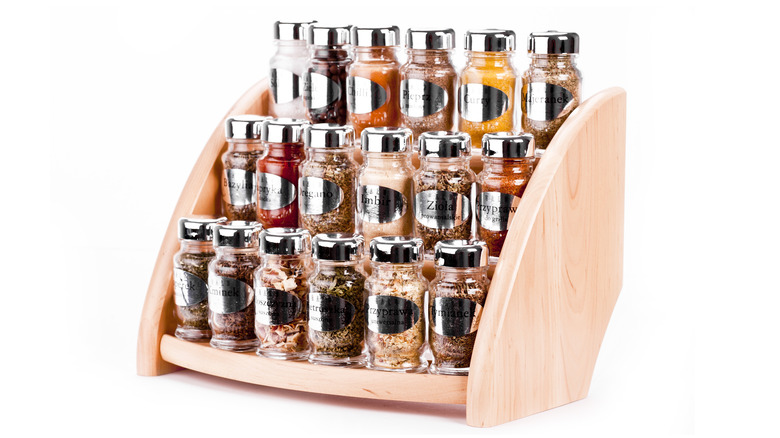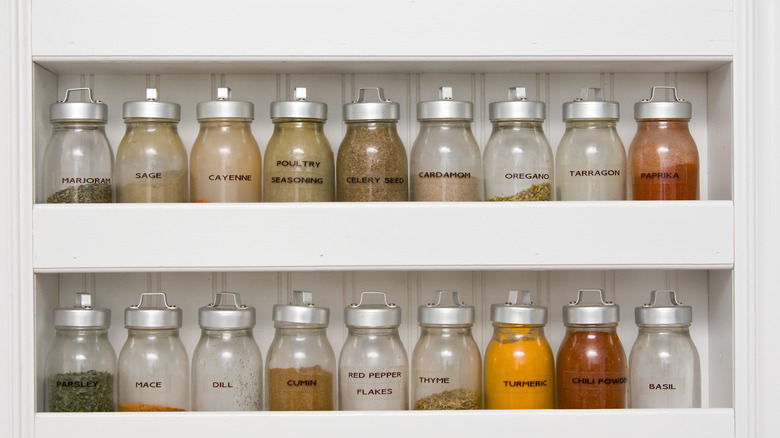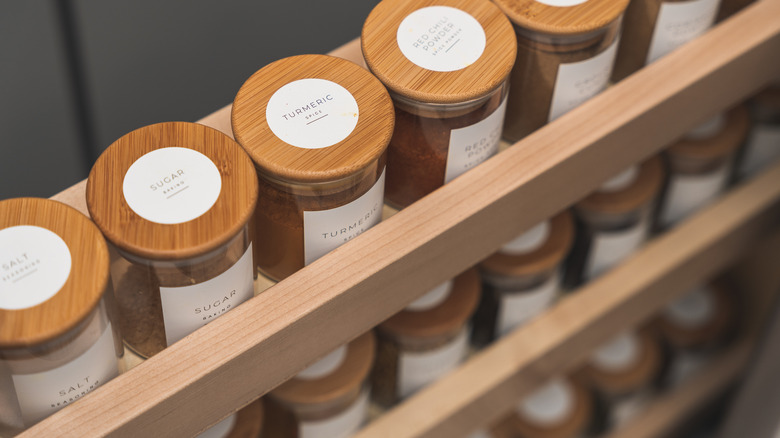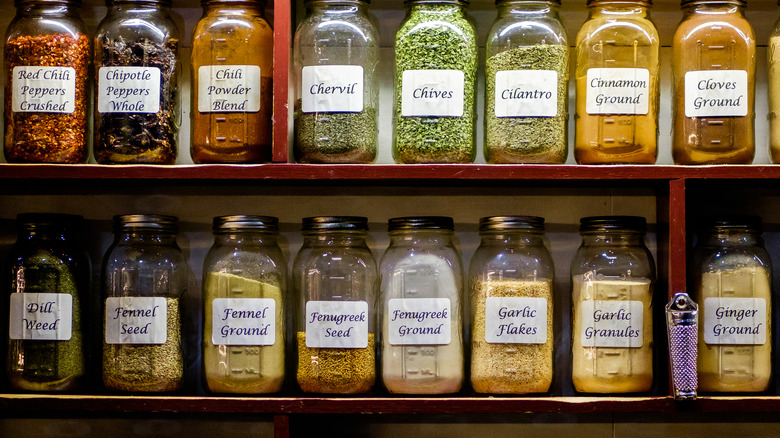5 Tips For Organizing Your Spice Cabinet
Just about everyone desires an organized spice cabinet, but not everyone puts the effort into making it happen. Why? If your spices are disorganized, maybe you can't justify putting the time into organizing them. Or, perhaps you're convinced that it's not that important, especially if your ingredients are tucked away in a closed cabinet. You may even think that your current system works just fine.
However, putting the time and effort into creating a spice cabinet that really works for you has a number of amazing benefits. Of course, it will make your kitchen more aesthetic — but that's just the beginning. Shelf Genie adds that it will make spices easier to use and access, because you know exactly where to find each one. Organizing your cabinet can also help your spices stay fresher. And, it may get you more excited about cooking, which could lead to more yummy home-cooked food and fewer last-minute pizza deliveries.
By now, you're probably convinced that you need to organize your spice cabinet. If so, below are five tips you'll need to know before you get started.
1. Place them in a closed cabinet or drawer
Some think that displaying their spices on countertops or open shelves is the best option. After all, leaving them out in the open would make them the most accessible. However, as explained by Food Network, spices need to be kept in a cool and dark area because this will help maintain their freshness. Associate Melody adds that heat, light, moisture, and air can all cause ingredients to lose their flavor and color, as well as to decrease in quality. Best Life points out that many of our kitchen appliances, including the stove and the dishwasher, produce a lot of heat, so storing your spices near these areas in the kitchen could reduce their quality as well.
Therefore, the best place to keep your ingredients is off of the countertops and inside a drawer or a closed cabinet. This will also provide you with more counter space to store smaller appliances like coffee makers or the toaster, and it will give your kitchen an overall organized appearance.
2. Use organizers
Spice organizers can make your spices easier to find while also improving the aesthetics of your space. When choosing the right organizer for you, Allrecipes says to first determine where you will be placing or installing the organizer. This will help you narrow down design choices. Next, consider what material you want your organizers to be made of. While plastic is easy to clean, it's not as durable as metal. Finally, think about how many spices you need and how large your kitchen is.
Those who have a very small kitchen or who really like their spices on the countertop may prefer a freestanding rack organizer that's closed off on all sides with sliding doors. Food & Wine features one of these models and shows how the labels are placed on the outside of each drawer, making finding each ingredient incredibly easy. However, if you choose a freestanding rack, make sure it's far away from any heat sources.
If you are placing your spices in a cabinet, a popular option is a tiered rack. This allows you to store jars behind one another while still making each easily accessible. Or, you could choose a spinning Lazy Susan, which would also make each one easy to find. If you're low on cabinet and drawer space, you could install shelving on the inside of your cabinet or pantry door.
3. Store spices in uniform containers
The next tip is to place all your spices in the same containers. You're probably thinking that this is purely for aesthetic reasons, but there are actually a number of other benefits as well. Of course, this will make your spices appear more uniform. But, as Closet Works points out, placing all your spices in airtight containers will also allow them to stay fresh for a longer amount of time. Further, they say that glass is the best material to choose because glass doesn't conduct heat like metal and isn't absorbent like plastic.
Another benefit of using all the same containers is that they will most likely fit better into your organizer. When organizing jars of all different shapes, there can be extra space wasted on the sides of shelves. On the other hand, if they're all the same shape and size, the containers can sit right next to each other. Additionally, using the same size jars will help you limit the size of the spices you buy, which can preserve your ingredients for a longer amount of time, per Associate Melody.
4. Label the containers
Once you've placed your spices into aesthetic glass jars, the next step is to label them. Labeling is important because it will make using your ingredients much easier. It will also keep you from buying the same ones over and over again because you can't find them, per South House Designs. Labels could be custom-made on Etsy to create the most aesthetic appearance. If you're more concerned with functionality, a sticker or piece of tape and a permanent marker will do. You could also write directly on a glass bottle with a permanent marker, as Rooms Need Love demonstrates.
The most important consideration is where to place the label so it can easily be seen. This will be determined by your specific organizer. For spices on their side, placing the label on the side of the jar will work best. For those with the top of the cap showing, place the label on the cap.
5. Create an easy-to-use system
Even when utilizing organizers, containers, and labels, finding the spices you need can still be difficult. This is especially true for those who have large collections. Therefore, to make your life easier, organize your spices in an easy-to-use system.
One of the most popular systems is to organize your spices alphabetically, per Vertical Spice. This will help you find your ingredients faster, and over time, you'll most likely memorize where each one is placed. To do this, take all your spices out and line them up in alphabetical order, then place them back into the organizer.
A Personal Organizer says that you could also group your spices by how they're used. For instance, nutmeg, cinnamon, and cloves would go in your baking section, while those used while grilling could go in your barbequing area. Other categories include sweet, spicy, and savory, or sort them by ethnicity. Similarly, you could also choose to categorize them in your own personal way, perhaps by how much you use them or what you associate them with.
